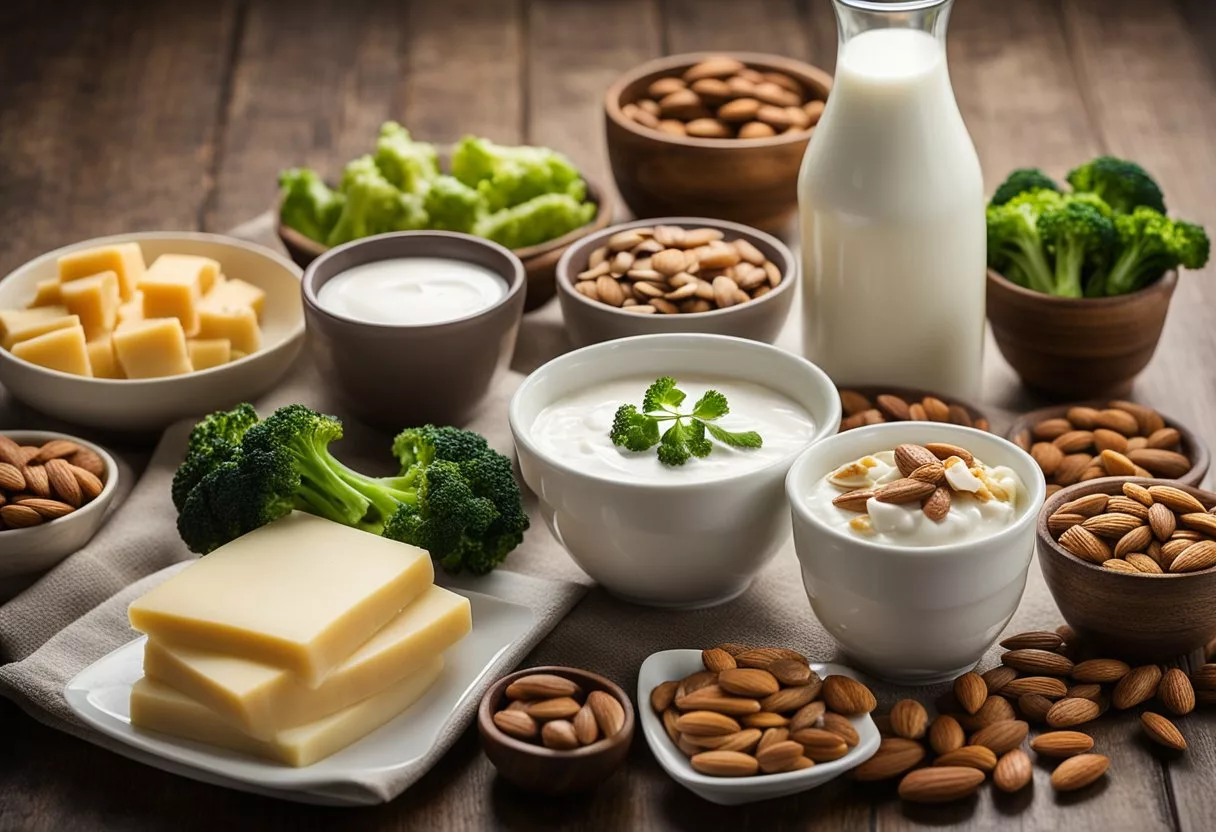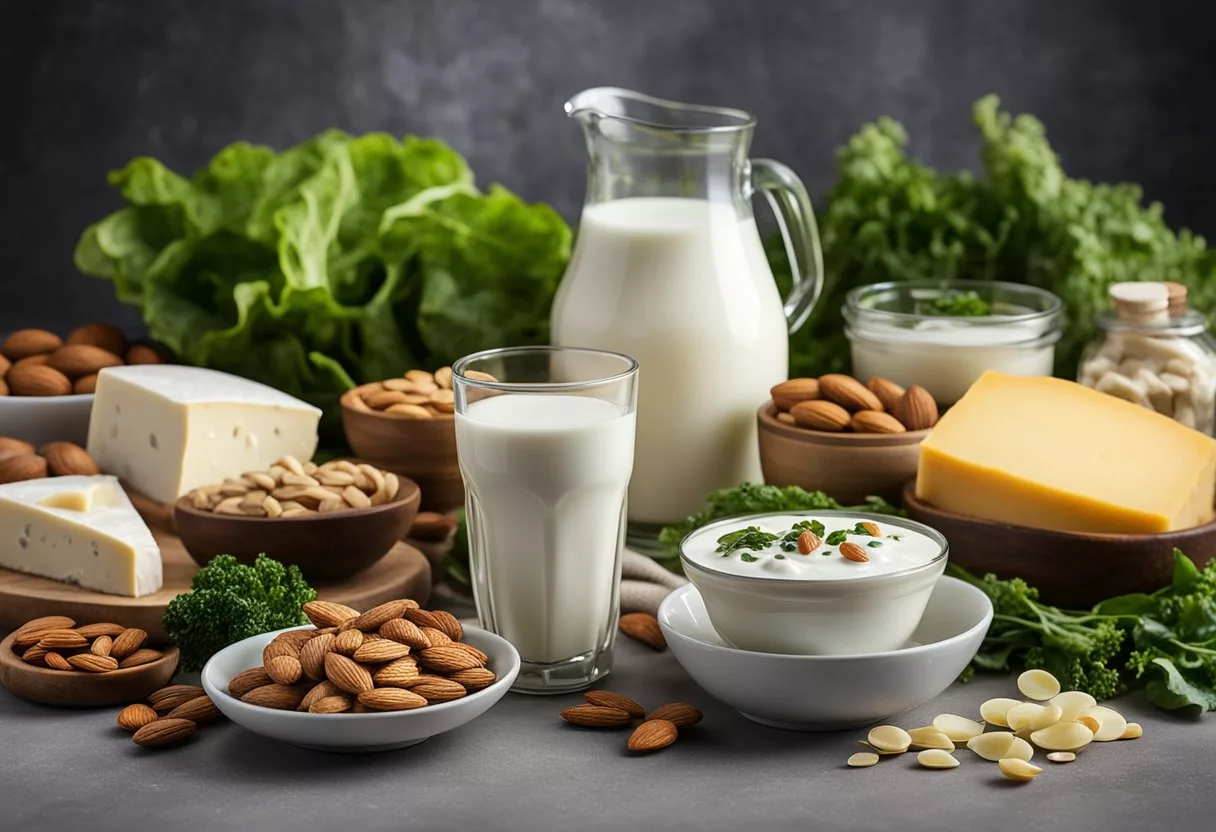Calcium is essential for strong bones and teeth, as well as for proper muscle and nerve function. While many think of dairy products like milk and cheese as the primary sources, there are numerous calcium-rich foods beyond dairy. Including a variety of calcium-rich foods in your diet can help meet your daily nutritional needs and support overall health.

Leafy greens such as kale and broccoli are excellent plant-based sources of calcium. Fish like salmon and sardines also provide significant amounts of this important mineral. For those who prefer fortified options, many cereals and juices are enriched with calcium, making it easier to maintain adequate levels without relying solely on dairy products.
Understanding the diverse sources of calcium is crucial for everyone at different life stages. From children who need it for growth to adults who require it to prevent osteoporosis, ensuring a varied intake of calcium-rich foods is key. Explore the benefits of diversifying your diet and discover simple ways to boost your calcium intake effortlessly.
Key Takeaways
- Variety in calcium-rich foods is essential for overall health.
- Leafy greens, fish, and fortified foods are great non-dairy sources.
- Calcium is crucial for bone health at all life stages.
Understanding Calcium in the Diet

Calcium is a key nutrient crucial for bone and teeth health. Knowing how to effectively incorporate it into your diet is essential to prevent issues like osteoporosis.
The Importance of Calcium
Calcium plays a vital role in the body, strengthening bones and teeth. It is necessary for muscle movements and nerve signals. People need sufficient calcium to prevent bone diseases later in life. In children and teenagers, it supports growth and development. Women, especially post-menopausal, are at a higher risk for osteoporosis and should ensure they get enough calcium. Men also need calcium to maintain strong bones and prevent bone loss as they age. Dairy products, leafy greens, and certain fishes are good sources of calcium.
Recommended Daily Value of Calcium
The daily recommended value of calcium varies by age and gender. Children ages 4-8 need about 1,000 mg per day, while teenagers need around 1,300 mg. Adults typically require 1,000 mg daily, but the amount increases to 1,200 mg for women over 50 and men over 70 to counteract bone density loss. Consuming a variety of calcium-rich foods like dairy, fortified plant milks, green vegetables, and canned fish helps meet these requirements.
Absorption and Interactions with Other Nutrients
Calcium absorption is influenced by several factors, including the presence of other nutrients. Vitamin D is essential for calcium absorption, so it is important to ensure adequate intake of this vitamin through sunlight or diet. Foods rich in phosphorus and magnesium also support bone health. On the other hand, high sodium and caffeine intake can reduce calcium absorption, leading to possible deficiencies. Vitamin K can also play a role in calcium regulation. Including a variety of these nutrients, and being mindful of factors that may inhibit absorption, ensures the body efficiently uses the calcium consumed. For more on this, visit Harvard.
Understanding the role of calcium, the daily requirements, and how it interacts with other nutrients can help maintain strong bones and prevent related health issues.
Dairy-Based Sources of Calcium

Calcium is plentiful in dairy products, which are also nutrient-rich. This section highlights the calcium content and nutritional benefits of milk, cheese, and yogurt.
Milk and Its Nutritional Profile
Milk is one of the most common sources of calcium. One cup of milk provides about 300 milligrams of calcium. Milk is also rich in vitamin D, which helps the body absorb calcium more effectively. Both skim milk and whole milk offer similar calcium levels, but skim milk has fewer calories and less fat.
For those with lactose intolerance, lactose-free milk is available, offering the same calcium content without digestive issues. Rich in protein and other essential nutrients, milk is a cornerstone of many diets.
Cheese Varieties High in Calcium
Cheese is another excellent source of calcium. Different types of cheese provide varying amounts of calcium. Parmesan cheese is one of the richest, with about 330 milligrams of calcium per ounce. Cheddar cheese also offers a good amount, with around 200 milligrams per ounce.
Mozzarella and ricotta cheeses are also notable. One cup of ricotta provides about 500 milligrams of calcium, making it an excellent choice for those looking to boost their intake. Cheese is versatile, adding flavor and nutrition to many dishes.
Yogurt and Health Benefits
Yogurt is a dairy product that supports calcium intake while promoting gut health. Greek yogurt is especially high in protein and can contain up to 200 milligrams of calcium per serving. Regular yogurt also provides significant calcium, with around 300 milligrams per cup.
Cottage cheese is another yogurt-like option, containing less calcium but still contributing to daily intake. Yogurt’s probiotics help maintain a healthy digestive system, making it a popular food for those focused on overall well-being.
Plant-Based Calcium Foods

Plant-based foods offer a variety of ways to get enough calcium. This includes leafy greens, fortified plant milks, and certain nuts, seeds, and legumes.
Leafy Greens and Calcium Content
Some of the best plant-based sources of calcium come from leafy greens. Kale and collard greens are excellent choices, with both providing substantial amounts of calcium. Kale offers around 150 mg per cup, while collard greens boast about 200 mg per cup.
Spinach is also high in calcium, but its oxalate content can impair calcium absorption. Bok choy and broccoli, on the other hand, have lower oxalate levels, making their calcium more bioavailable. Broccoli provides about 62 mg per cup, making it a good addition to a calcium-rich diet.
Fortified Plant Milks and Juices
Fortified foods are an essential source of calcium for many on a plant-based diet. Soy milk is one of the most popular options, providing around 300 mg of calcium per cup, similar to cow’s milk. Almond milk is also fortified and contains about the same amount of calcium per cup.
Fortified orange juice is another valuable source. It typically contains about 350 mg of calcium per cup. These beverages not only offer calcium but also come with additional nutrients like vitamin D, which helps in calcium absorption.
Nuts, Seeds, and Legumes
Nuts, seeds, and legumes are also key players in a calcium-rich diet. Almonds are a great example, providing about 75 mg of calcium per ounce. Chia seeds and sesame seeds are especially rich sources, with 1 ounce of chia seeds offering about 180 mg of calcium.
Tofu made with calcium sulfate is another excellent source, offering up to 350 mg per half-cup serving. Other legumes like edamame provide about 98 mg per cup, making them a smart addition to meals. Beans and lentils, while somewhat lower in calcium, still contribute meaningfully to daily intake.
Fish as a Source of Calcium

Fish, especially canned varieties, can be a significant source of calcium. Canned salmon and sardines, for example, are particularly nutrient-rich and offer notable amounts of calcium. Additionally, omega-3 fatty acids found in these fish may play a role in enhancing calcium absorption.
Canned Salmon and Sardines
Canned salmon and sardines are excellent sources of calcium. This is because they include soft, edible bones which are rich in calcium. A can of sardines can provide about 27% of the daily value (DV) for calcium, whereas canned salmon with bones offers approximately 19% of the DV per 3-ounce serving.
In addition to calcium, these fish are also rich in other essential nutrients, such as vitamin D and protein. These nutrients support bone health, making canned salmon and sardines a good choice for those seeking to increase their calcium intake.
The Role of Omega-3 Fatty Acids in Calcium Absorption
Omega-3 fatty acids, which are abundant in fish, like salmon and sardines, may enhance calcium absorption in the body. Omega-3s are known for their anti-inflammatory properties and overall benefits for heart health.
Some studies suggest that omega-3s can help improve bone density by enhancing calcium absorption and reducing bone loss. These healthy fats may complement the high calcium content of canned fish to further support bone health.
By including fish high in omega-3 fatty acids and calcium in your diet, you can simultaneously benefit from improved heart health and stronger bones.
Calcium Fortification in Foods
Calcium fortification enhances the nutrient content of common foods. This process ensures people have more options to meet their dietary calcium needs by incorporating it into everyday items like cereals and beverages.
Understanding Fortified Foods
Fortified foods are those where nutrients, often lacking in many diets, are added. Calcium-fortified foods include products like orange juice, soy milk, and breakfast cereals. This supplementation aims to help consumers meet their daily nutritional requirements more easily.
A key benefit of calcium fortification is that it allows people who are lactose intolerant or avoid dairy to still get essential nutrients. For example, fortified soy milk provides an alternative to cow’s milk, helping individuals achieve their calcium intake without dairy.
Cereals and Calcium Enrichment
Many breakfast cereals are enriched with calcium. Enriching cereals with calcium helps consumers start their day with an added nutritional boost. For instance, fortified cereals can contain between 100–1000 mg of calcium per serving.
The types of calcium used in fortification, such as calcium carbonate and calcium citrate, vary but commonly help enhance bioavailability. Adding calcium to cereals means even those with limited access to dairy can receive ample calcium to support bone health.
Beverages with Added Calcium
Beverages like fortified orange juice and soy milk are common examples of calcium-fortified foods. Fortified orange juice often contains an added 300 mg of calcium per glass, making it a significant source for non-dairy drinkers.
Soy milk, another popular choice, can match or exceed the calcium content of cow’s milk when fortified, usually around 300 mg per cup. This makes it an excellent substitute for those who prefer plant-based diets while still accessing essential nutrients to support their health.
Incorporating these fortified beverages allows for a versatile diet, accommodating various nutritional needs and preferences.
Calcium Through the Life Stages

Calcium requirements change with age. It’s essential to meet these needs to support bone health, especially during growth and aging.
Calcium Needs for Children and Adolescents
Children and adolescents need higher amounts of calcium to support rapid bone development. This period is crucial for building bone mass that will sustain them throughout life. Boys and girls aged 9-18 require around 1300 mg of calcium per day.
Encouraging physical activity, like sports and dance, helps in bone strengthening. Foods such as dairy products, leafy greens, and fortified cereals are excellent sources of calcium. Consuming these foods can help meet the daily requirements easily.
Calcium Intake for Adults and Older Adults
For adults, calcium intake is crucial to maintain bone density and prevent bone loss. Men and women aged 19-50 need about 1000 mg of calcium daily. This helps in keeping bones strong and supports overall health.
As adults age, particularly past 50, calcium needs increase. Postmenopausal women are at a higher risk of bone loss due to decreases in estrogen levels. They often need around 1200 mg of calcium daily. Older adults should prioritize calcium-rich foods like dairy, leafy greens, and fish with bones to maintain their bone health effectively.
Health Implications of Calcium Intake

Calcium plays a vital role in maintaining bone health, preventing various diseases, and supporting essential body functions. However, consuming too much calcium can lead to health risks.
Connection Between Calcium and Bone Disorders
Calcium is crucial for bone health and plays a key role in preventing bone disorders such as osteoporosis. Osteoporosis causes bones to become weak and prone to fractures. Adequate calcium intake helps build strong bones during childhood and maintains bone density as we age.
Calcium deficiency can lead to poor bone health and increase the risk of fractures. Foods rich in calcium, such as milk, yogurt, cheese, and green leafy vegetables like kale and broccoli, are essential for maintaining strong bones.
Calcium’s Role in Disease Prevention
Calcium may reduce the risk of certain diseases beyond bone disorders. It is involved in nerve function, muscle contraction, and blood clotting. Some research suggests calcium may lower the risk of heart disease and help manage blood pressure. For instance, the presence of vitamin D can enhance calcium absorption, supporting cardiovascular health (Mayo Clinic).
Moreover, diets high in calcium-rich foods can decrease the risk of kidney stones. It’s important for individuals to focus on dietary sources rather than supplements for optimal health benefits.
Risks of Excessive Calcium Intake
While calcium is beneficial, excessive intake can cause health issues. Too much calcium from supplements can increase the risk of kidney stones and possibly heart disease. Excess calcium can also lead to high blood calcium levels, causing symptoms like nausea, constipation, and abnormal heart rhythms.
Individuals should moderate their calcium intake, considering both dietary sources and supplements. It’s recommended to get calcium primarily from foods like dairy products, sardines, and certain vegetables to avoid the risks associated with high calcium levels.
Balancing calcium intake with dietary considerations and monitoring overall consumption helps in maintaining optimal health without the negative effects of excess intake.
Supplementing Calcium in Your Diet

Choosing proper calcium supplements and knowing how to take them effectively is important for maintaining bone health and meeting daily calcium needs. This section will guide you in selecting the best supplements and provide tips on maximizing their benefits.
Choosing the Right Calcium Supplements
When selecting calcium supplements, consider the type and the amount. The two main types are calcium carbonate and calcium citrate.
Calcium carbonate is cost-effective and contains the highest amount of elemental calcium, but it requires stomach acid for absorption. It’s best taken with meals. Calcium citrate, on the other hand, is easier on the stomach and can be taken with or without food. It’s a good choice for people with low stomach acid or digestive issues.
Check the serving size and milligrams of calcium in each dose. A registered dietitian can help determine the right supplement based on individual needs. Look for products with a certified quality mark to ensure purity and accuracy.
How to Take Calcium Supplements Effectively
To maximize calcium absorption, split the daily intake into smaller doses (no more than 500 mg at a time). This helps the body utilize the mineral more effectively.
Take calcium carbonate with food, as stomach acid aids its absorption. Calcium citrate can be taken with or without food. Pairing calcium with vitamin D is beneficial, as vitamin D enhances calcium absorption.
Avoid taking calcium supplements at the same time as high-iron meals or supplements, as they can interfere with each other’s absorption. Staying hydrated and following dosage instructions are also critical.
By carefully choosing and taking calcium supplements, calcium intake can meet the recommended daily value, promoting better bone health and preventing deficiencies.
Practical Tips for Increasing Calcium Intake

Eating calcium-rich foods is essential for maintaining strong bones and teeth. Here are some practical tips to help boost your calcium intake:
1. Include Dairy Products:
Dairy is an excellent calcium source. Drink a glass of milk, eat a cup of yogurt, or enjoy cheese with your meals. For example, a cup of milk provides about 25% of the daily recommended calcium intake.
2. Fortified Foods:
Choose fortified foods like calcium-fortified beverages such as soymilk or orange juice. These products have added calcium to help meet daily needs.
3. Leafy Greens:
Incorporate leafy greens like kale and bok choy into your diet. Although spinach is high in calcium, it contains oxalic acid which reduces calcium absorption.
4. Nuts and Seeds:
Snack on nuts like almonds or add chia seeds to your breakfast. These are good plant-based sources of calcium.
5. Fish:
Eat fish with soft bones, such as sardines and canned salmon. These provide both calcium and protein, essential nutrients for bone health.
6. Beans and Legumes:
Add beans and legumes like chickpeas and lentils to your diet. They offer a good amount of calcium and other vital nutrients.
Food Diaries and Serving Sizes:
Keep a food diary to track your calcium intake. Be mindful of serving sizes to ensure you are consuming enough calcium daily. According to the U.S. Department of Agriculture, accurate serving sizes help in reaching the recommended daily intake.
Use Milk in Cooking:
Use milk or calcium-fortified alternatives when cooking. Replace water with milk in oatmeal or soups to increase calcium content.
Frequently Asked Questions

Calcium is essential for healthy bones and teeth. This section covers common questions about the best sources of calcium, how to enhance its absorption, and recommendations for daily intake.
What are some top calcium-rich fruits to include in the diet?
Figs, oranges, and blackberries are excellent fruit sources of calcium. An orange provides about 6% of the Daily Value (DV), while dried figs contain around 5% per serving.
Which vegetables are known for their high calcium content?
Leafy greens like kale and bok choy are rich in calcium. Broccoli and Brussels sprouts also provide significant amounts. For example, one cup of cooked kale offers about 10% of the DV.
How can one ensure they are getting enough calcium for bone health?
To ensure adequate calcium intake, incorporate a variety of calcium-rich foods into your diet. This can include dairy products, fortified plant milks, and leafy greens. Regular medical check-ups can help monitor and maintain optimal bone health.
What are the best vegetarian sources of calcium?
Almonds, tofu, and chia seeds are some of the best vegetarian sources of calcium. Fortified plant milks, such as almond or soy milk, also provide comparable amounts of calcium to dairy milk.
What strategies can help increase calcium absorption from food?
Eating calcium-rich foods with those high in vitamin D, such as salmon or eggs, can boost absorption. Avoid consuming high amounts of oxalates and phytates from foods like spinach or beans at the same time as calcium to improve bioavailability.
What amount of daily calcium intake is recommended for adults?
For most adults, the recommended daily amount of calcium is 1,000 milligrams. Women over 50 and men over 70 should increase their intake to 1,200 milligrams per day to support bone health.